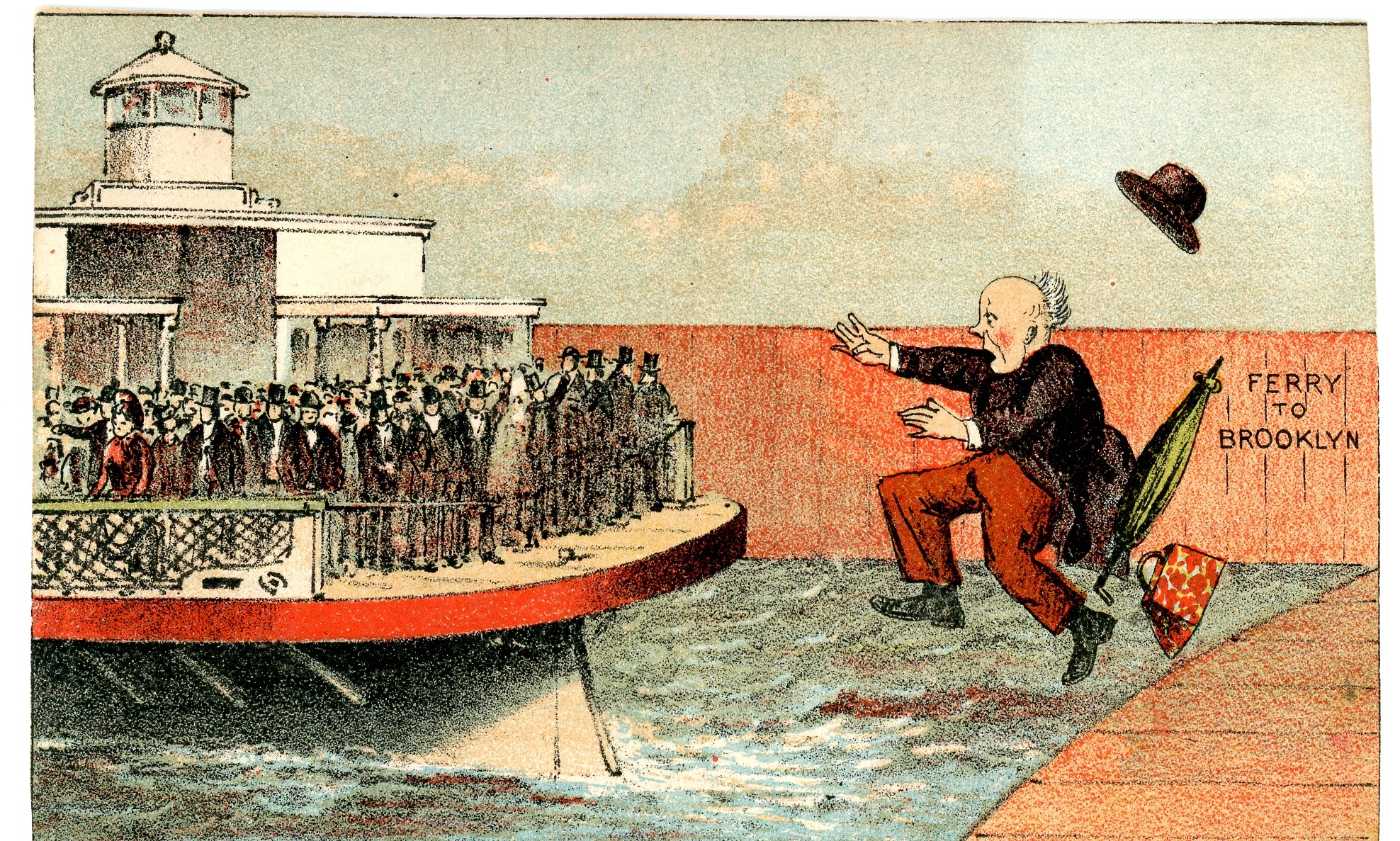Looking at some NYC ferries and their namesakes
A Collections Chronicles Blog
by Michelle Kennedy, Collections and Curatorial Assistant
September 16, 2021
When I hop on a New York City bus or step into a subway car, I never think about whether the vehicle I’m riding has a name beyond its route designation. Though cars and buses may have combinations of letters and numbers assigned by the MTA, I would only describe the subway as the “N train” or the bus as the “M60”.
The ferries that cross New York City’s waterways have a bit more personality. I’m delighted if I get to ride on Seas the Day, John A. Noble, or Ferry Godmother. Though the names of some New York City ferries might be the most whimsical they have ever been (looking at you Lunchbox), there have been ferries with meaningful names serving the city for centuries- let’s take a short walk through history looking at a few of the boats that have carried New Yorkers as well as the boats’ namesakes.
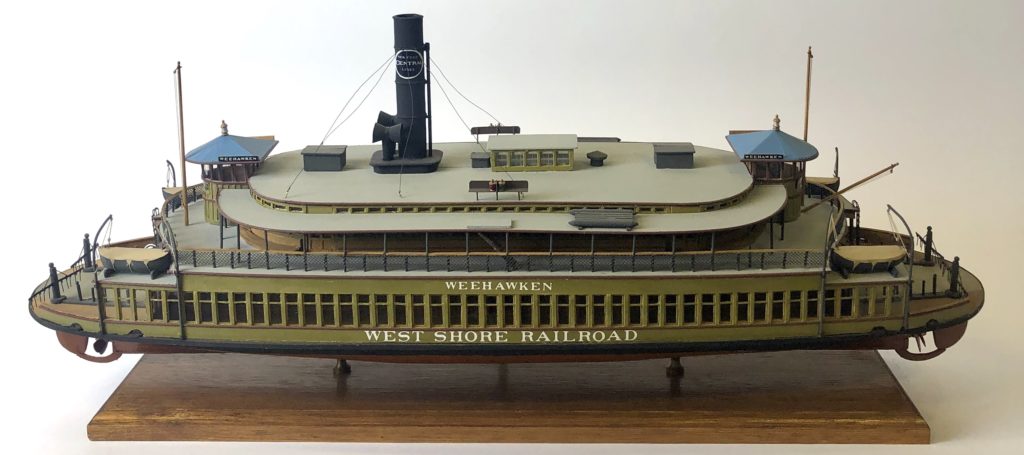
Col. Walter R. Bruyere III (American, 1916-2004). “New York Central Lines-West Shore Railroad ferryboat Weehawken”, 1991. Basswood, metal, plastic, string, paint. Gift of Walter Bruyere, South Street Seaport Museum 1991.043
Before the Steam Ferry
New York City is both divided and connected by its waterways. The Hudson River connects the city to the north of New York State (and the nation’s interior with the opening of the Erie Canal); the East River provides a link to the Long Island Sound, and the Lower New York Bay leads to the Atlantic Ocean and intercontinental shipping routes. As a port city, New York’s many waterways welcome ships and boats but pose a challenge to land-based transit like carts, horses, and people on foot—particularly in the centuries before suspension bridges and underground tunnels. Ferries were once the main for carrying people and goods across the port.
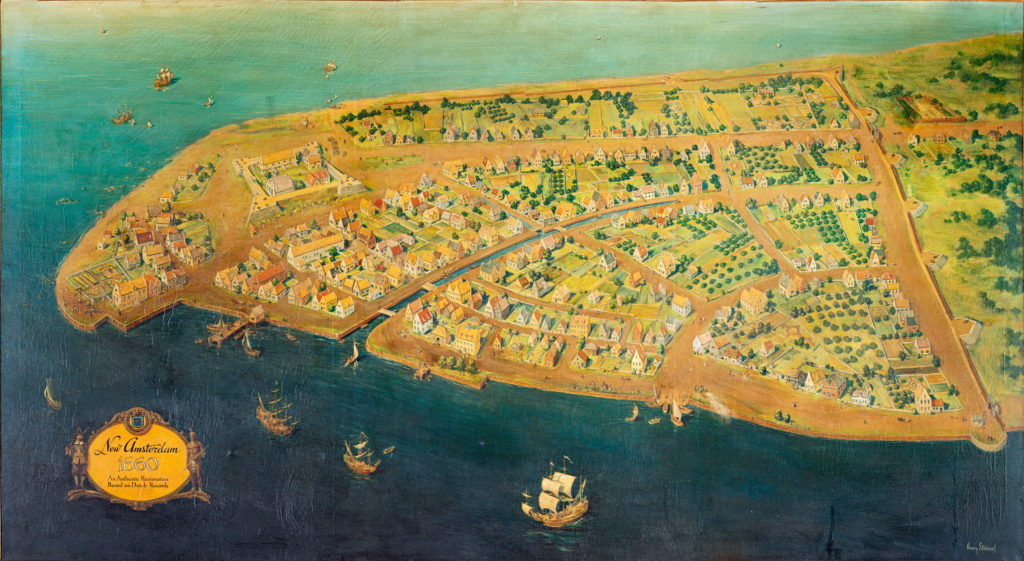
The first ferries date back to the New Amsterdam era. The colony was founded in 1624 on the southern tip of Manhattan, an area that was long inhabited and utilized by the Lenape. By 1636 Dutch settlers were moving across the East River to set up plantations in what would become Breuckelen (Brooklyn).
Henry Stoessel (American, 1909-1984) “New Amsterdam in 1660”, Mid 20th-century. Oil on canvas. Gift of Janet U. Schaefer, South Street Seaport Museum 1983.043.0001
Regular ferry service was first established in 1642 by Cornelis Dircksen Hooglandt who, according to Henry G. Bayer’s 1925 history The Belgians: First Settlers in New York and in the Middle States, would row passengers in a small skiff from today’s Peck Slip to Brooklyn. The name of this early ferry has been lost to time reflecting the fragmentary information about ships and boats that survive in 17th century records of New Netherland.
Ferries would be operated privately (though the Common Council began leasing the rights for regular ferry operators) throughout the colonial period. These early ferries were limited by their reliance on sails and oars, and were susceptible to currents and bad weather. It was with the development of the steam ferryboat at the beginning of the 19th century that New York City ferry service would progress into a reliable form of transit.
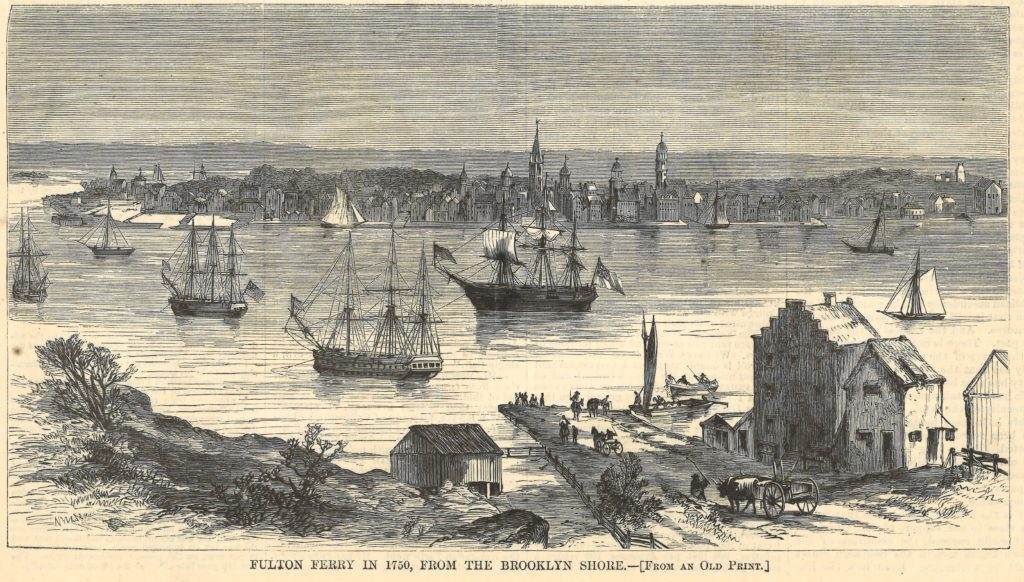
Harper’s Weekly, publisher. “Fulton Ferry in 1750 from the Brooklyn Shore”, November 2, 1872. Paper, ink. Gift of Mavis P. Kelsey, M.D., South Street Seaport Museum 1998.007.0009
Fulton Ferry, Fulton Street, Fulton Station…
A blog discussing the history of the New York City ferry and the names given to its ferryboats would be incomplete without a section on Robert Fulton (1765-1815). Robert Fulton came to the US in 1806 having demonstrated a successful steamboat in Paris three years prior. His plan, with his business partner Robert R. Livingston (1746-1813), was to bring steam powered boats to New York City. He demonstrated the possibilities with Clermont in 1807, which travelled from New York to Albany under steam. This boat was officially named The North River Steamboat which may sound generic today but operated in a time when it truly was the only North (Hudson) River steamboat.
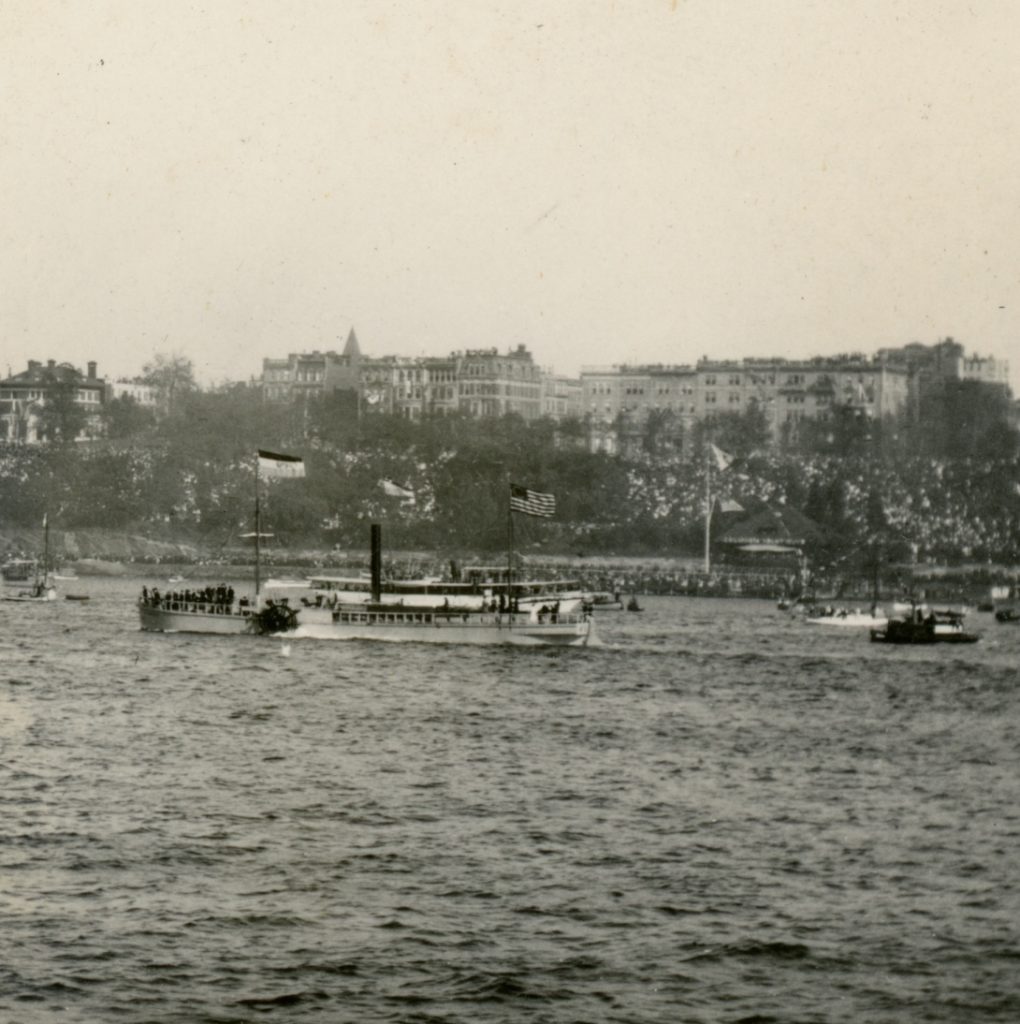
Cleveland Arthur Dunn (American, 1873-1956), photographer. [The replica of North River Steamboat Clermont sailing in the Hudson River] 1873-1956. Photographic print. Gift of Joan A. Wright, South Street Seaport Museum 2006.019.0001
Fulton and Livingston’s venture was also commercially successful. Livingston had seen the potential for steamships years prior, and in 1798 had secured a monopoly from New York State as the exclusive operator of steam-powered vessels (including ferries) for two decades that would go into effect after a successful demonstration. The monopoly would only end in 1824 after the Supreme Court judged it unconstitutional, especially since New York state had presumed that the exclusivity extended to travel to other states— even when crossing the Hudson River to and from New Jersey. Under their monopoly, and before his premature death in 1815, Fulton would inaugurate two regular New York steam ferry lines across the Hudson. In 1814, he would also commence an East River steam ferry service with the steamboat Nassau.

Since he was integral to the development of steamboats in New York, Robert Fulton has many namesakes as both vessels and otherwise. The line initially served by Nassau from the foot of Fulton Street in what would become the South Street Seaport Historic District to the foot of Fulton Street, Brooklyn would become the “Fulton Ferry”. Three NYC ferryboats have been named Fulton, and a Hudson River Day Line excursion steamer was christened Robert Fulton.
“Fulton Street Sign”, ca.1910-1960. Vitreous enamel on metal. Gift of Charles Emmons, South Street Seaport Museum 1980.078
A City Connected by Water
When the corporate successor to Fulton and Livingston’s venture lost their monopoly on passenger steam travel in New York, an era of intense competition between commercial steam ferries began. The growth of the city throughout the 19th century led to the proliferation of routes, companies, and vessels that can hardly be covered in a single blog post. Though most ferries were simply named for the geographic areas they served (such as the multiple ferries named Brooklyn, New York, New Brunskwick, Whitehall, etc.) a few have names that illustrate other aspects of the ferry system.
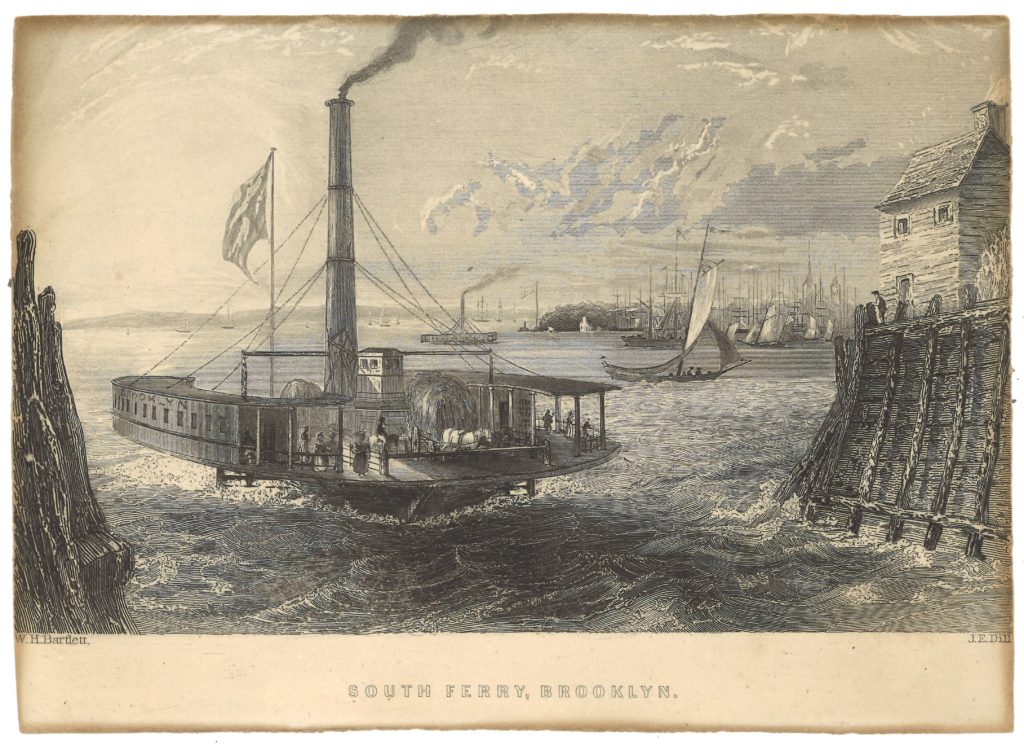
William Henry Bartlett (English, 1809-1854) “South Ferry, Brooklyn” 1838 (original). Paper, ink. South Street Seaport Museum 1988.086
Maybe it’s not surprising, but the demand for East River ferry routes was particularly intense. Brooklyn had evolved from a small outpost of plantations in the New Amsterdam era to a city in its own right. Many people who worked in Manhattan took up residence in Brooklyn and commuted over the East River. However, early steam ferries were still susceptible to floating ice. Passengers who relied on the Fulton Ferry were so upset at regularly occurring delays that operator Union Ferry Company added two ferries in 1836 named Relief and Olive Branch as a peace offering.
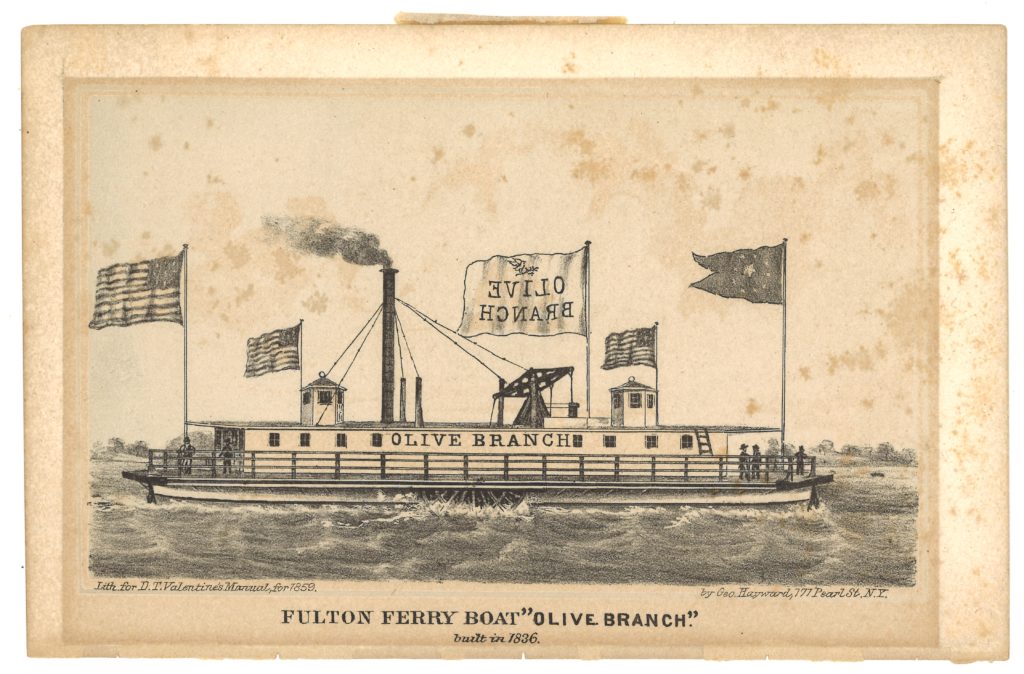
George Hayward, (American, ca. 1800–ca. 1872); D.T. Valentine’s Manual, publisher. “Fulton Ferry Boat Olive Branch”, 1859. Paper, ink. From the Collection of Rosa and Robert McRoberts, South Street Seaport Museum 1981.045.0003
The explosion of railroads in New York and surrounding states from the 1840s onwards only increased the demand for reliable passenger travel in New York City waterways. Before train tunnels and bridges, people who wanted to get from Manhattan or Brooklyn to the rail depots in New Jersey and all points west needed to take a ferry.
The Pennsylvania Railroad (PRR), like many railroad companies in New York City, also operated ferries, but there was an independent company that saw an opportunity in providing ferries to the PRR NJ depots without direct railroad oversight. The Pennsylvania Annex ran a route from Brooklyn to Jersey City that bypassed Manhattan entirely starting in 1877. Their ferries were creatively named Annex, Annex No. 2, Annex No.3 and so on, but they represent the exponential growth in ferry service during the late 19th century.
The number of New York City ferry vessels would continue to increase every year until 1904. In 1908, NYC ferryboats reported a total of 201,300,000 passenger rides. The ferry system was at its peak, and several changes were underway.
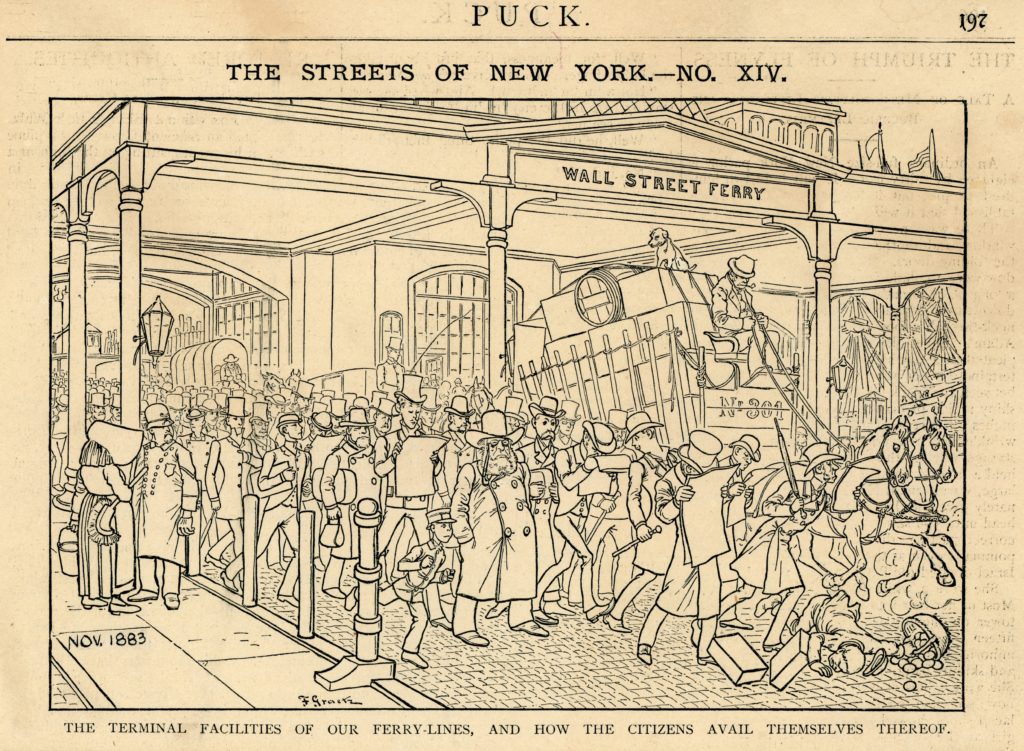
Friedrich Graetz (Austrian, 1840-1913); Puck, publisher. “The Terminal Facilities of our Ferry-Lines, and How the Citizens Avail Themselves Thereof” November 1883. Paper, ink. Seamen’s Bank for Savings Collection, South Street Seaport Museum 2003.040
The City’s Ferries
In 1905, New York City began a progressive takeover of ferries, transforming large parts of what had been a series of competing commercial interests into a municipal ferry system. The first route to be acquired would become what is known today as the Staten Island Ferry, running between Whitehall Street and Saint George. The ferry system was greatly expanded under Mayor John F. Hylan (1868-1936), who believed in public control of local transit services, with new routes and new turbo-electric powered ferryboats.
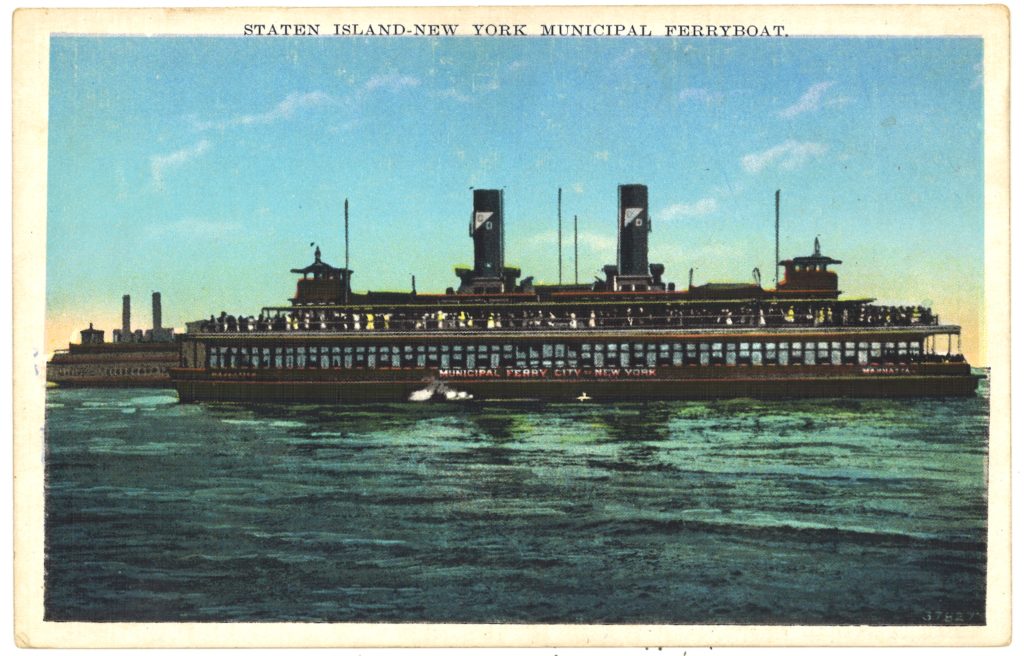
Weitzman’s Photo Shop, publisher. “Staten Island- New York Muncipal Ferryboat” early 20th century. Paper, ink. Postcard Collection, South Street Seaport Museum Archives
Hylan was known for naming his ferryboats after political allies and allegedly even tried to name one after himself. He would launch William Randolph Hearst, Rodman Wanamaker, and George Loft in 1923—all named for wealthy and well-connected men involved in New York politics. Mayor Hylan’s naming choices were not uncontroversial, and his successor Mayor Jimmy Walker (1881-1946) even renamed Hearst and Loft to Whitehall and West Brighton respectively.
The issue of what political cronies would be honored with a New York City ferry stopped in 1934 when Mayor Fiorello La Guardia (1882- 1947) signed a law mandating any city owned vessel named in someone’s honor must be done so posthumously. New York City ferries that were named after people were then generally after either fallen military personnel or represented a large group of people. The ferry Gold Star Mother, for example, was named for American mothers who lost sons or daughters in service of the United States Armed Forces.
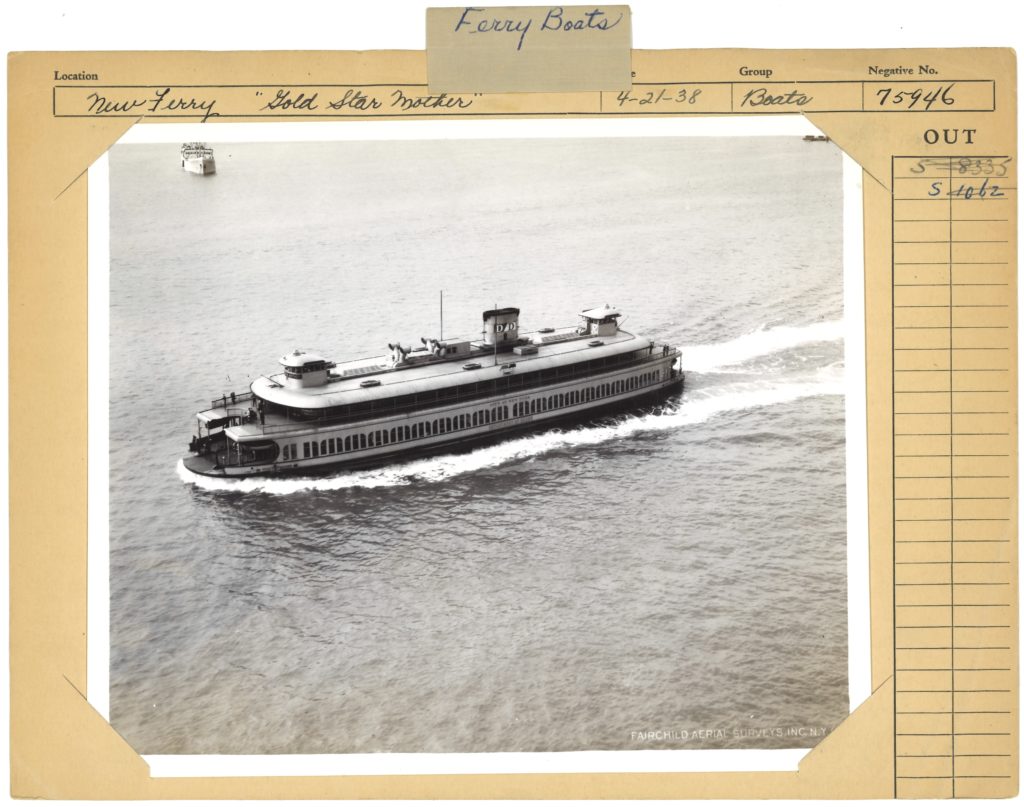
Fairchild Aerial Surveys, Inc., photography. “Gold Star Mother” April 21, 1938. Photographic print. Gift from an anonymous donor, South Street Seaport Museum 2018.008.0084
The heyday of the municipal ferry coincided with the decline in City ferry ridership per capita. The Brooklyn Bridge marked the first non-waterborne transportation route across the East River in 1883, followed by a series of other bridges over the decades connecting Manhattan to its neighbors. The first underwater subway tunnel connecting Brooklyn and Manhattan opened in 1908, ushering in a new era of underground public transit. Infrastructure that served automobiles took priority for many city planners by the mid 20th century. By 1945, the only municipal ferry route that remained was the first that had been city operated: the Staten Island Ferry.
Ferries Today
There has been a resurgence in interest in ferry transit and waterfront development in recent decades, and this blog was initially inspired by the ferries that are currently crossing the New York waterways. Today the NYC Department of Transportation only directly operates the Staten Island ferry while other routes are run by operators like New York Waterway, Seastreak, and NYC Ferry by Hornblower.
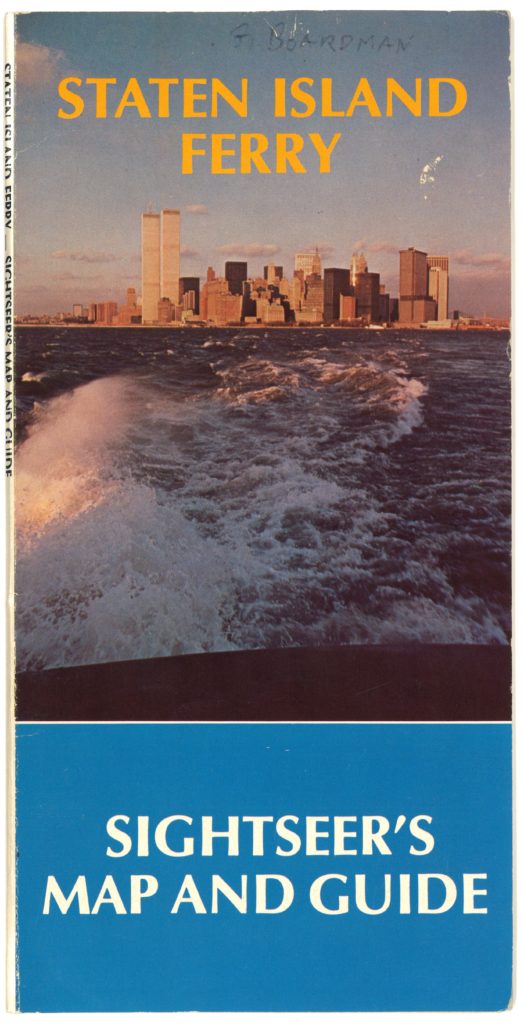
The Staten Island Ferry continues to largely name their vessels by locations in the boroughs being served and honoring posthumous residents.
Three new ferry boats were commissioned for the Staten Island ferry in 2021. Their names are Staff Sgt. Michael Ollis, Dorothy Day, and Sandy Ground. All three names have direct ties to the borough of Staten Island.
Ollis was the first of the three ferries to be announced and was named in honor of Michael Ollis (1988-2013), an Army Staff Sergeant from New Dorp who was killed while protecting fellow soldiers in Afghanistan.
The second ferry is named for Dorothy Day (1897-1980), a journalist and social activist who was a leader in the Catholic Worker Movement and a long-time Staten Island resident. This is the third Staten Island ferry to be named after a specific woman, following Mary Murray and Alice Austen.
Sandy Ground is named for an area in Staten Island now located in Rossville. Sandy Ground is the continuously settled free black community in the United States and was an important stop on the Underground Railroad.
Staten Island Ferry Sightseer’s Map and Guide, ca. 1975. Paper, ink. South Street Seaport Museum Archives
NY Waterway, which has operated in the Hudson River since 1986, has named some of their newest additions after significant figures in American history including Franklin D. Roosevelt (1882-1945), Betsy Ross (1752-1836), and Molly Pitcher—believed to be an amalgamation of several women who acted on the frontlines of the American Revolution including Mary Hays (1754-1832).
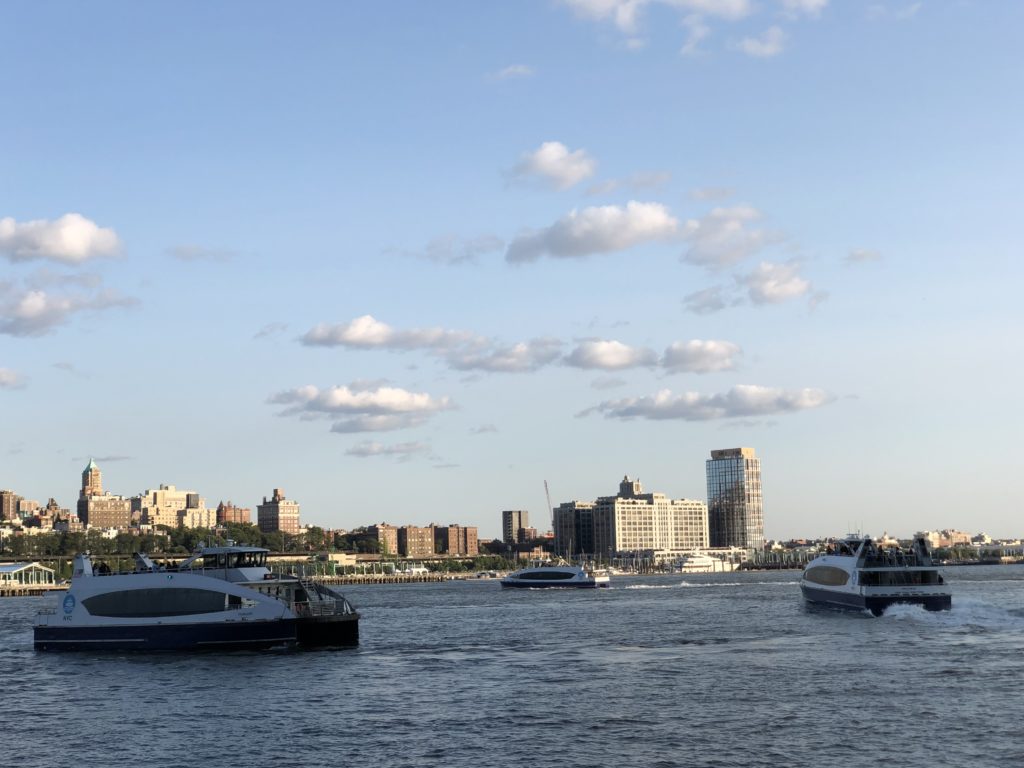
For NYC Ferry, operator Hornblower went with a less conventional process for naming their boats: by asking second graders. The punny ferry names that I mentioned in the introduction of this blog are the result of the ferry naming competitions held by Hornblower from 2017-2019.
Thousands of second-grade classrooms across New York City were asked to submit a name for a ferry and a short paragraph on why their name was best.
Three NYC Ferry leaving and approaching Pier 11 landing, Lower Manhattan. September 10, 2021.
Names like Melting Pot and Forget Me Knot, submitted by P.S. 31 in Greenpoint and P.S. 102 in Bay Ridge, were inspired by the diversity of the students’ neighborhoods and the connections recent immigrants felt for their new and past communities.
The students of P.S. 516 in Sunset Park who came up with Tooth Ferry explained their choice was inspired by the excitement of riding the ferry: “Losing teeth is one of the exciting things that happen to 2nd graders. We think lots of second graders would be pumped to ride a ferry called Tooth Ferry. We also think this would be a funny name for the ferry.”
NYC Ferry has published the winning names and the creative thought processes that accompanied them to their website–check it out if you find them as delightful as I do.
Bon Voyage
The New York City ferry system has grown along with the city itself. The history of how the New Yorkers have stayed connected commercially, culturally, and personally, cannot be disentangled from the waters that surround our community.
Though this blog was only a brief and sporadic look at aspects of the vessels that have carried us over the waterways, I hope the next time you board a ferry you feel connected to a long and ever-evolving tradition of this great port city.
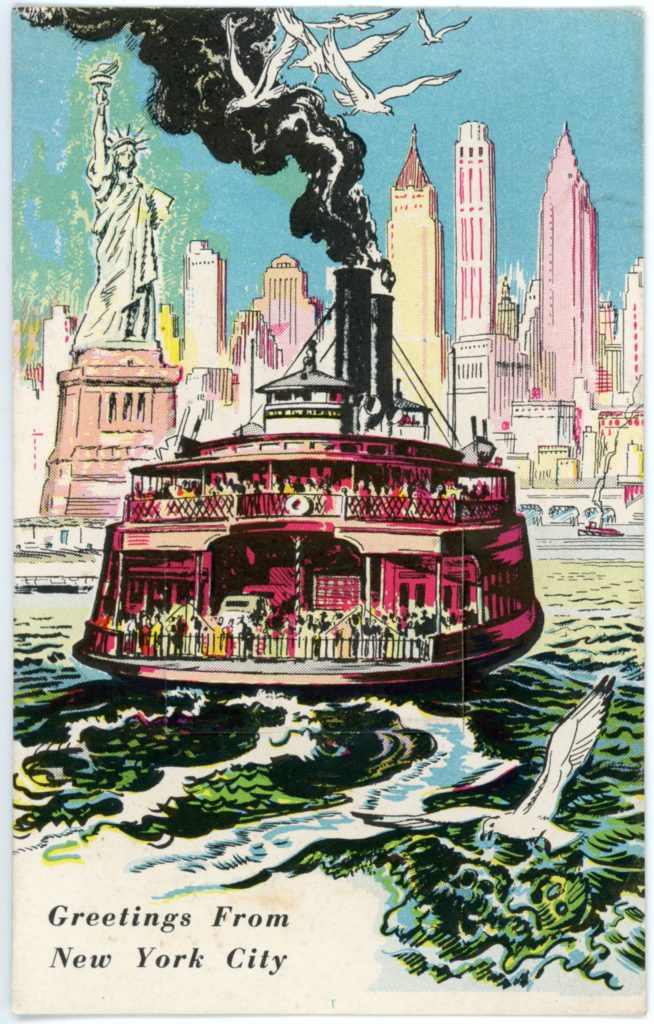
Progressive Publications, Inc., publisher. “Greetings from New York”, 20th century. Paper, ink. Gift of Peter Neill, South Street Seaport Museum 1997.021.0001
Additional readings and resources
“The Belgians, First Settlers in New York and in the Middle States” by Henry G. Bayer, 1925, p. 171.
“Ship and Work Boats of New Netherland 1609-1674” by Charlotte Wilcoxen, published by the New Netherlands Institute, pp. 53-54.
“Paddles & Profits: Robert Fulton Brings Steam to the Hudson Page” by Cynthia Owen Phillip, published in Seaport, Fall 1985, p. 20.
“Over and Back: the History of Ferryboats in New York Harbor” by Brian J. Cudahy, 1990.
“Cross from shore to shore” by Norman Brouwer, published in Seaport, Spring 1992, p. 65.
“The Rise, Fall, and Rise Again of the New York City Municipal Ferry System” by Patricia Glowinski, August 23, 2019. NYC Department of Records and Information Services Blog.
“Yank Marine Newbuild Joins NY Waterway Ferry Fleet” by Baird Maritime, May 14, 2020.
“New Staten Island Ferry Boat to be Named for Dorothy Day, Renowned Social Activist Who Lived and Worked on Staten Island” March 25, 2021.
“A Tour of New Netherland- Breuckelen (Brooklyn)” Digital Exhibition, New Netherlands Institute.
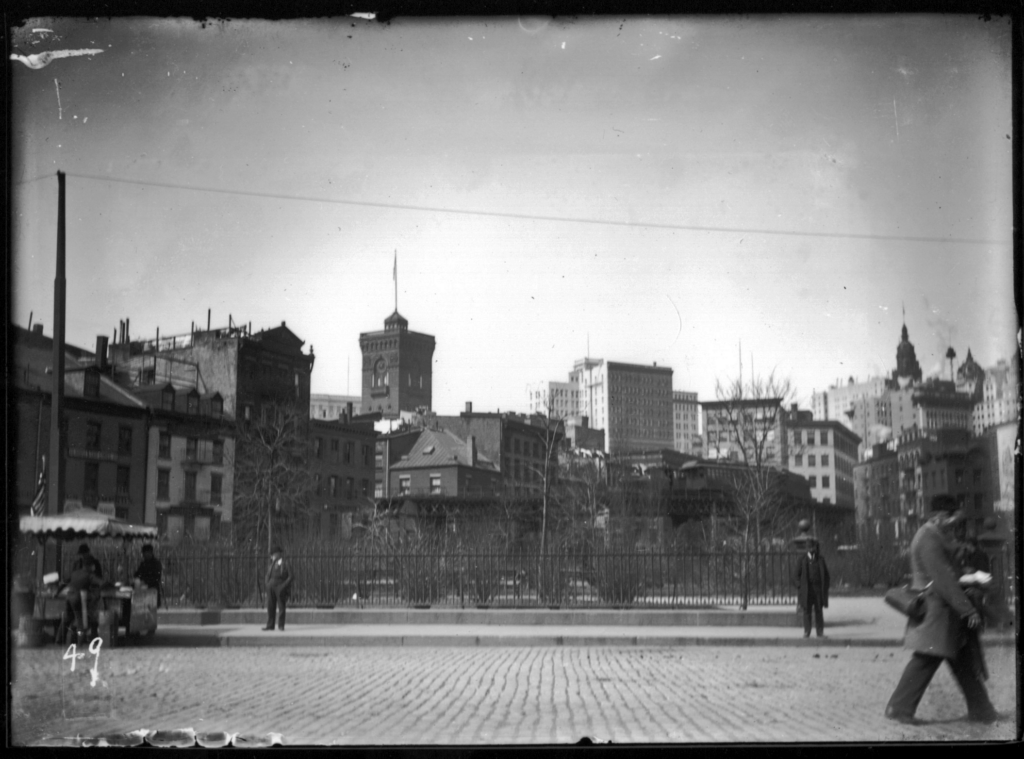
Looking for more virtual tours?
Check out our content in created partnership with Urban Archive. Discover the origins of New York’s greatness by taking one of our virtual tours of Lower Manhattan and the South Street Seaport Historic District, or download the Urban Archive iPhone app from their page to experience our virtual stories and tours.

